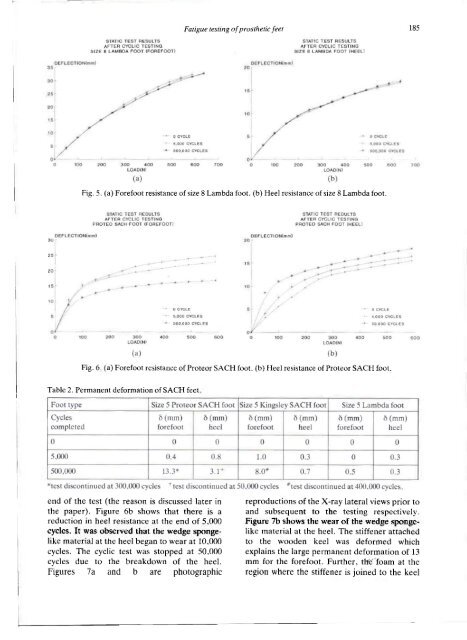Fatigue testing of energy storing prosthetic feet
Fatigue testing of energy storing prosthetic feet
Fatigue testing of energy storing prosthetic feet
Create successful ePaper yourself
Turn your PDF publications into a flip-book with our unique Google optimized e-Paper software.
<strong>Fatigue</strong> <strong>testing</strong> <strong>of</strong> <strong>prosthetic</strong> <strong>feet</strong> 185<br />
Fig. 5. (a) Forefoot resistance <strong>of</strong> size 8 Lambda foot, (b) Heel resistance <strong>of</strong> size 8 Lambda foot.<br />
Fig. 6. (a) Forefoot resistance <strong>of</strong> Proteor SACH foot, (b) Heel resistance <strong>of</strong> Proteor SACH foot.<br />
Table 2. Permanent deformation <strong>of</strong> SACH <strong>feet</strong><br />
end <strong>of</strong> the test (the reason is discussed later in reproductions <strong>of</strong> the X-ray lateral views prior to<br />
the paper). Figure 6b shows that there is a and subsequent to the <strong>testing</strong> respectively.<br />
reduction in heel resistance at the end <strong>of</strong> 5,000 Figure 7b shows the wear <strong>of</strong> the wedge spongeto<br />
the wooden keel material was at deformed the heel began which to wear at cycles. It was observed that the wedge sponge-like 10,00<br />
cycles. The cyclic test was stopped at 50,000<br />
cycles due to the breakdown <strong>of</strong> the heel.<br />
Figures 7a and b are photographic<br />
explains the large permanent deformation <strong>of</strong> 13<br />
mm for the forefoot. Further, the foam at the<br />
region where the stiffener is joined to the keel
















